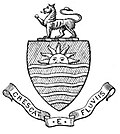| Emblem of Punjab | |
|---|---|
 | |
| Armiger | Government of Punjab |
| Crest | Wheat stem |
| Shield | Lion Capital of Ashoka |
| Supporters | Crossed talwar swords |
| Motto | सत्यमेव जयते Satyameva Jayate Truth alone triumphs |
The Emblem of Punjab is the official state emblem of the Indian state of Punjab and it is used as the official symbol of the Government of Punjab. [1] [2] [3]








